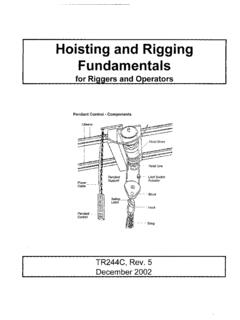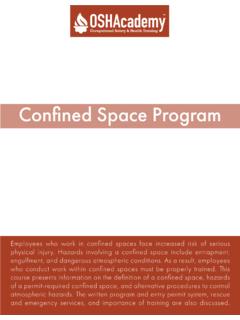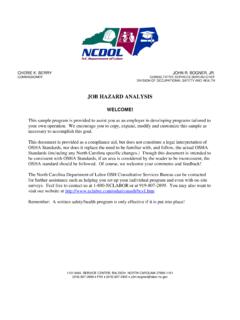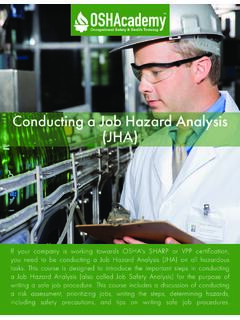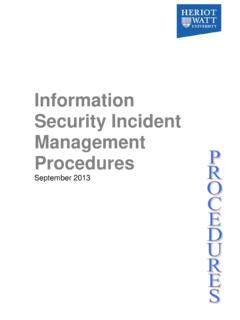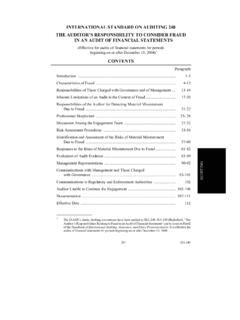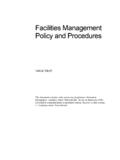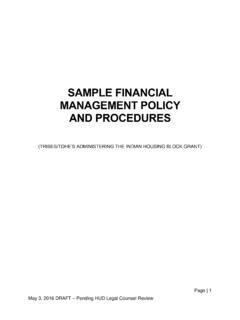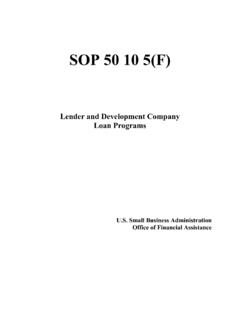Transcription of 736 Introduction to Process Safety Management
1 The major purpose of Process Safety Management (PSM) of highly hazardous chemicals is to prevent unwanted released of hazardous chemicals, especially into locations that could expose employees and others to serious hazards. This course is intended to introduce students to the basic requirements in the PSM standard, the need for Process Safety , and the tools used to implement Process Safety Management systems. It covers the 14 elements required by the standard and some of the tools used to address Process Safety requirements, identify hazards, and manage to Process Safety Management (PSM)Course 736 This page intentionally blank Course 736 OSHA cademy Course 736 Study Guide Introduction to Process Safety Management Copyright 2022 Geigle Safety Group, Inc.
2 No portion of this text may be reprinted for other than personal use. Any commercial use of this document is strictly forbidden. Contact OSHA cademy to arrange for use as a training document. This study guide is designed to be reviewed off-line as a tool for preparation to successfully complete OSHA cademy Course 736. Read each module, answer the quiz questions, and submit the quiz questions online through the course webpage. You can print the post-quiz response screen which will contain the correct answers to the questions. The final exam will consist of questions developed from the course content and module quizzes.
3 We hope you enjoy the course and if you have any questions, feel free to email or call: OSHA cademy 15220 NW Greenbrier Parkway, Suite 230 Beaverton, Oregon 97006 + Disclaimer This document does not constitute legal advice. Consult with your own company counsel for advice on compliance with all applicable state and federal regulations. Neither Geigle Safety Group, Inc., nor any of its employees, subcontractors, consultants, committees, or other assignees make any warranty or representation, either express or implied, with respect to the accuracy, completeness, or usefulness of the information contained herein, or assume any liability or responsibility for any use, or the results of such use, of any information or Process disclosed in this publication.
4 GEIGLE Safety GROUP, INC., DISCLAIMS ALL OTHER WARRANTIES EXPRESS OR IMPLIED INCLUDING, WITHOUT LIMITATION, ANY WARRANTIES OF MERCHANTABILITY OR FITNESS FOR A PARTICULAR PURPOSE. Taking actions suggested in this document does not guarantee that an employer, employee, operator or contractor will be in compliance with applicable regulations. Ultimately every company is responsible for determining the applicability of the information in this document to its own operations. Each employer s Safety Management system will be different. Mapping Safety and environmental Management policies, procedures , or operations using this document does not guarantee compliance regulatory requirements.
5 Revised: January 10, 2022 This page intentionally blank Course 736 Contents Course Introduction .. 1 The purpose for Process Safety Management (PSM) .. 1 Module 1: Why We Have Process Safety Management .. 2 The Problem .. 2 A Disastrous Record .. 3 OSHA Responds .. 5 The Clean Air Act Amendments and the PSM Standard .. 5 CAAA Requirements for the PSM Standard .. 6 OSHA s PSM Standard .. 6 What are the benefits of an effective PSM program? .. 9 Module 2: How the PSM Standard 10 Application .. 10 What is a Process ?
6 10 What industries does PSM target? .. 11 What does the employer need to develop? .. 11 PSM Impact .. 12 How to Reduce Risk .. 12 Who is not covered by the PSM Standard? .. 12 Module 3: The PSM 14 Elements .. 14 Process Safety Information .. 14 Hazards of the Chemicals Used in the Process .. 15 Technology of the Process .. 15 Course 736 Types of Process Flow Diagrams .. 16 Block Flow Diagrams .. 17 Process Flow Diagrams .. 18 Equipment in the Process .. 19 Equipment in the Process .. 20 Module 4: Process Hazard Analysis (PHA).
7 21 What is a PHA? .. 21 Steps in the PHA Process .. 21 Prioritizing PHAs .. 22 Methods for Conducting the PHA .. 23 Deciding Methods to Use in a PHA .. 24 Minimum PHA Method Requirements .. 25 The PHA Team .. 25 Team Expertise .. 26 Employer Response to PHA Team Findings .. 27 Review and Revalidation .. 28 Module 5: operating procedures .. 29 Employer Requirements .. 29 operating Procedure 29 Elements of the operating procedures .. 30 operating Procedure Requirements .. 31 operating procedures Review .. 32 Course 736 Module 6: Employee Participation and Training.
8 34 Employers duty to involve employees .. 34 Initial Training .. 34 Refresher Training .. 35 Training Documentation .. 35 Module 7: Contractors .. 37 Application .. 37 Employer Responsibilities .. 37 Contract Employer Responsibilities .. 38 Pre-Startup Safety Review .. 39 Module 8: Mechanical Integrity and Hot Work Permit .. 41 Mechanical Integrity .. 41 Training .. 41 Inspection and Testing .. 42 Equipment Deficiencies and Quality Assurance .. 42 Hot Work Permit .. 43 Optional Exercise .. 44 Module 9 MOC, Investigation, Emergency Response and Trade Secrets.
9 46 Management of Change (MOC) .. 46 Incident Investigation .. 47 Emergency Planning and Response .. 48 Compliance Audits .. 49 Course 736 Trade Secrets .. 50 The Future of PSM .. 50 Final words of PSM wisdom! .. 51 Course 736 Copyright 2022 Geigle Safety Group, Inc. Page 1 of 52 Course Introduction The purpose for Process Safety Management (PSM) The major purpose of Process Safety Management (PSM) of highly hazardous chemicals is to prevent unwanted releases of hazardous chemicals, especially into locations that could expose employees and others to serious hazards.
10 OSHA simply states a hazardous chemical is any chemical which is a physical hazard or a health hazard. An effective Process Safety Management program requires a systematic approach to evaluating the whole chemical Process . Using this approach, the Process design, Process technology, Process changes, operational and maintenance activities and procedures , non-routine activities and procedures , emergency preparedness plans and procedures , training programs, and other elements that affect the Process are all considered in the evaluation.

